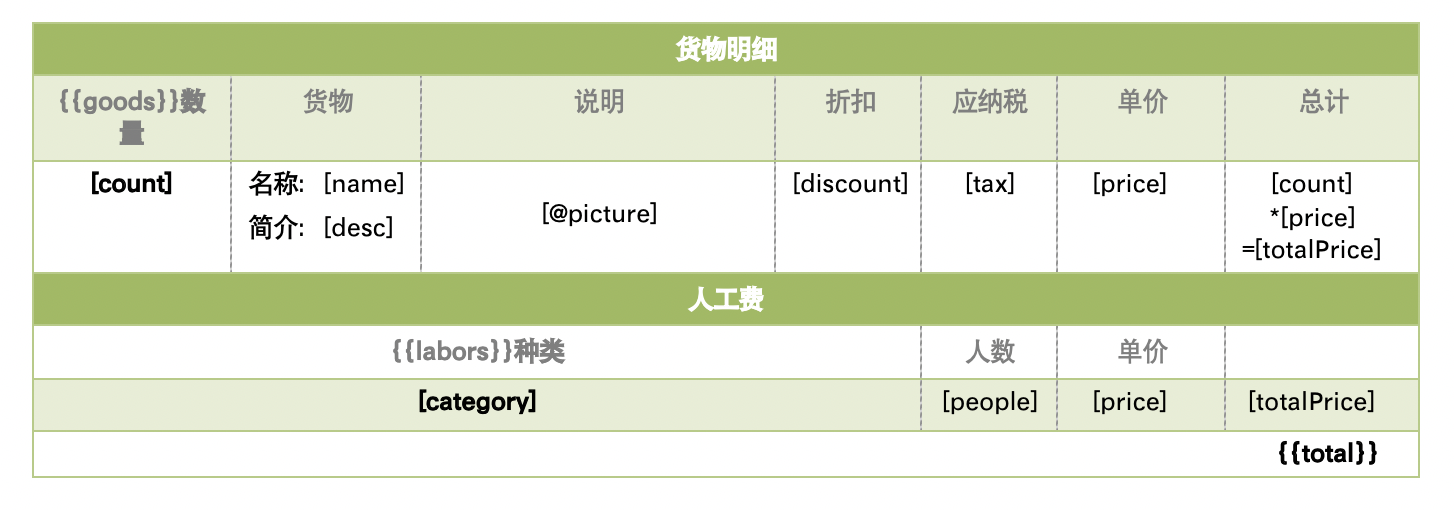前言
poi-tl(poi template language)是 Word 模板引擎,使用模板和数据创建很棒的 Word 文档。
在文档的任何地方做任何事情(Do Anything Anywhere)是 poi-tl 的星辰大海。
通过表格插入图片列表,并按图片原始比例缩放图片
注意,当前方案针对的是 poi-tl-1.10.6 版本。
在表格中,可以通过 @ 标签插入图片,如下图中的 [@picture]:

若循环变量的元素为
PictureRenderData,则需以[@#this]方式引入图片。
其最终由在 com.deepoove.poi.config.Configure 的构造函数中默认注册的插件
com.deepoove.poi.policy.PictureRenderPolicy 做数据渲染。
不过,PictureRenderPolicy 仅支持在
com.deepoove.poi.data.PictureRenderData.getPictureStyle().getScalePattern()
为 WidthScalePattern.FIT 时按所在单元格的宽度做图片的缩放,这通常会造成图片被拉伸,影响视觉效果。
而若是要保证图片在单元格内不被拉伸,则需要让其按照其原始比例进行缩放,
为此,需要重载 PictureRenderPolicy:
public class PictureAutoFitRenderPolicy extends PictureRenderPolicy {
@Override
public void doRender(RenderContext<PictureRenderData> context) throws Exception {
renderPicture(context.getRun(), context.getData());
}
private static void renderPicture(XWPFRun run, PictureRenderData picture) throws Exception {
// 与 com.deepoove.poi.policy.PictureRenderPolicy.Helper#renderPicture 的实现相同
// ...
if (!isSetSize(style)) {
int[] size = getFittedSize(run, imageBytes);
width = size[0];
height = size[1];
}
// 与 com.deepoove.poi.policy.PictureRenderPolicy.Helper#renderPicture 的实现相同
// ...
}
private static int[] getFittedSize(XWPFRun run, byte[] imageBytes) {
BufferedImage original = BufferedImageUtils.readBufferedImage(imageBytes);
int width = original.getWidth();
int height = original.getHeight();
double ratio = 1;
BodyContainer bodyContainer = BodyContainerFactory.getBodyContainer(run);
// 适配所在容器宽度
int pageWidth = UnitUtils.twips2Pixel( //
bodyContainer.elementPageWidth((IBodyElement) run.getParent()) //
);
if (width > pageWidth) {
ratio = pageWidth / (double) width;
}
// 适配表格高度
if (bodyContainer instanceof CellBodyContainer) {
int pageHeight = UnitUtils.twips2Pixel( //
((XWPFTableCell) bodyContainer.getTarget()) //
.getTableRow().getHeight() //
);
if (height > pageHeight) {
ratio = Math.min(ratio, pageHeight / (double) height);
}
}
width = (int) (width * ratio);
height = (int) (height * ratio);
return new int[] { width, height };
}
private static boolean isSetSize(PictureStyle style) {
return (style.getWidth() != 0 || style.getHeight() != 0) //
&& style.getScalePattern() == WidthScalePattern.NONE;
}
}
并重新注册 @ 标签的渲染插件:
Configure conf = Configure.builder().build();
conf.plugin(GramerSymbol.IMAGE.getSymbol(), new PictureAutoFitRenderPolicy());
而在 PictureAutoFitRenderPolicy 中最核心的处理逻辑为:
// 适配表格高度
if (bodyContainer instanceof CellBodyContainer) {
int pageHeight = UnitUtils.twips2Pixel( //
((XWPFTableCell) bodyContainer.getTarget()) //
.getTableRow().getHeight() //
);
if (height > pageHeight) {
ratio = Math.min(ratio, pageHeight / (double) height);
}
}
也就是,当图片在表格单元格内时,获取其单元格所在行的高度,再计算其高度缩放比例, 并从宽度的缩放比中选择最小值最为最终的宽高缩放比,从而实现图像缩放后的宽高比与原图的宽高比相同, 确保图像不会被拉伸。
修复在文本框中渲染的 HTML 行距无故放大的问题
注意,当前方案针对的是 poi-tl-1.10.6 + poi-tl-ext-0.4.15 版本,。
在文本框(TextBox)中使用 poi-tl-ext 做 HTML 渲染时,可能会出现行距被强制加大了,并且无法通过设置行距的方式使其恢复正常效果。
之所以在文本框内渲染 HTML,是为了便于控制文本的高度,以避免内容超出预期范围而造成内容分页等问题。
而且,该问题的出现还具有一定的不确定性,但经过实测发现,出现该问题时,都是因为渲染后的 HTML 段落被默认启用了 Snap to grid when document grid is defined,而且无法在模板内取消。
故而,只能通过代码强制取消该设置:
HtmlRenderPolicy htmlRenderPolicy = new HtmlRenderPolicy(globalFont, globalFontSize) {
@Override
protected void afterRender(RenderContext<String> context) {
super.afterRender(context);
IBody container = context.getContainer();
List<IBodyElement> bodyElements = container.getBodyElements();
bodyElements.forEach((element) -> {
if (element instanceof XWPFParagraph) {
CTPPr pPr = RenderUtils.getPPr(((XWPFParagraph) element).getCTP());
CTOnOff off = CTOnOff.Factory.newInstance();
off.setVal(STOnOff.Enum.forString("0"));
pPr.setSnapToGrid(off);
}
});
}
};
Configure conf = Configure.builder()
.bind("html", htmlRenderPolicy);
.build();
也就是,在按照默认逻辑完成 HTML 的渲染后,再遍历段落,并强制关闭 SnapToGrid。
参考资料
- 文章作者: flytreeleft - flytreeleft@crazydan.org
- 文章链接: https://studio.crazydan.org/blog/cases-for-poi-tl/
- 版权声明: 本文章采用许可协议《署名 4.0 国际 (CC BY 4.0)》。 转载或商用请注明来自 Crazydan Studio!